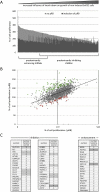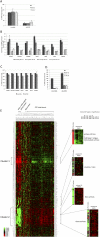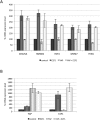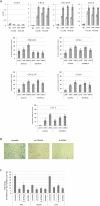A kinase shRNA screen links LATS2 and the pRB tumor suppressor
- PMID: 21498571
- PMCID: PMC3078707
- DOI: 10.1101/gad.2000211
A kinase shRNA screen links LATS2 and the pRB tumor suppressor
Abstract
pRB-mediated inhibition of cell proliferation is a complex process that depends on the action of many proteins. However, little is known about the specific pathways that cooperate with the Retinoblastoma protein (pRB) and the variables that influence pRB's ability to arrest tumor cells. Here we describe two shRNA screens that identify kinases that are important for pRB to suppress cell proliferation and pRB-mediated induction of senescence markers. The results reveal an unexpected effect of LATS2, a component of the Hippo pathway, on pRB-induced phenotypes. Partial knockdown of LATS2 strongly suppresses some pRB-induced senescence markers. Further analysis shows that LATS2 cooperates with pRB to promote the silencing of E2F target genes, and that reduced levels of LATS2 lead to defects in the assembly of DREAM (DP, RB [retinoblastoma], E2F, and MuvB) repressor complexes at E2F-regulated promoters. Kinase assays show that LATS2 can phosphorylate DYRK1A, and that it enhances the ability of DYRK1A to phosphorylate the DREAM subunit LIN52. Intriguingly, the LATS2 locus is physically linked with RB1 on 13q, and this region frequently displays loss of heterozygosity in human cancers. Our results reveal a functional connection between the pRB and Hippo tumor suppressor pathways, and suggest that low levels of LATS2 may undermine the ability of pRB to induce a permanent cell cycle arrest in tumor cells.
Figures







Comment in
-
Sweet DREAMs for Hippo.Genes Dev. 2011 May 1;25(9):889-94. doi: 10.1101/gad.2050411. Genes Dev. 2011. PMID: 21536729 Free PMC article.
Similar articles
-
DYRK1A protein kinase promotes quiescence and senescence through DREAM complex assembly.Genes Dev. 2011 Apr 15;25(8):801-13. doi: 10.1101/gad.2034211. Genes Dev. 2011. PMID: 21498570 Free PMC article.
-
WBP2 promotes gastric cancer cell migration via novel targeting of LATS2 kinase in the Hippo tumor suppressor pathway.FASEB J. 2021 Feb;35(2):e21290. doi: 10.1096/fj.202000393R. FASEB J. 2021. PMID: 33475198
-
Phosphorylation of pRB at Ser612 by Chk1/2 leads to a complex between pRB and E2F-1 after DNA damage.EMBO J. 2007 Apr 18;26(8):2083-93. doi: 10.1038/sj.emboj.7601652. Epub 2007 Mar 22. EMBO J. 2007. PMID: 17380128 Free PMC article.
-
[Molecular mechanisms controlling the cell cycle: fundamental aspects and implications for oncology].Cancer Radiother. 2001 Apr;5(2):109-29. doi: 10.1016/s1278-3218(01)00087-7. Cancer Radiother. 2001. PMID: 11355576 Review. French.
-
Molecular basis for the actions of Hsp90 inhibitors and cancer therapy.J Antibiot (Tokyo). 2011 Sep;64(9):635-44. doi: 10.1038/ja.2011.60. Epub 2011 Aug 3. J Antibiot (Tokyo). 2011. PMID: 21811259 Review.
Cited by
-
The DREAM complex: master coordinator of cell cycle-dependent gene expression.Nat Rev Cancer. 2013 Aug;13(8):585-95. doi: 10.1038/nrc3556. Epub 2013 Jul 11. Nat Rev Cancer. 2013. PMID: 23842645 Free PMC article. Review.
-
MiR-93 enhances angiogenesis and metastasis by targeting LATS2.Cell Cycle. 2012 Dec 1;11(23):4352-65. doi: 10.4161/cc.22670. Epub 2012 Oct 30. Cell Cycle. 2012. PMID: 23111389 Free PMC article.
-
DYRK1A: the double-edged kinase as a protagonist in cell growth and tumorigenesis.Mol Cell Oncol. 2015 Jan 30;2(1):e970048. doi: 10.4161/23723548.2014.970048. eCollection 2015 Jan-Mar. Mol Cell Oncol. 2015. PMID: 27308401 Free PMC article. Review.
-
Post-transcriptional gene expression control by NANOS is up-regulated and functionally important in pRb-deficient cells.EMBO J. 2014 Oct 1;33(19):2201-15. doi: 10.15252/embj.201488057. Epub 2014 Aug 6. EMBO J. 2014. PMID: 25100735 Free PMC article.
-
Evidence for autoregulation and cell signaling pathway regulation from genome-wide binding of the Drosophila retinoblastoma protein.G3 (Bethesda). 2012 Nov;2(11):1459-72. doi: 10.1534/g3.112.004424. Epub 2012 Nov 1. G3 (Bethesda). 2012. PMID: 23173097 Free PMC article.
References
-
- Adams PD 2009. Healing and hurting: molecular mechanisms, functions, and pathologies of cellular senescence. Mol Cell 36: 2–14 - PubMed
-
- Alexander K, Yang HS, Hinds PW 2003. pRb inactivation in senescent cells leads to an E2F-dependent apoptosis requiring p73. Mol Cancer Res 1: 716–728 - PubMed
-
- Alonso A, Rahmouni S, Williams S, van Stipdonk M, Jaroszewski L, Godzik A, Abraham RT, Schoenberger SP, Mustelin T 2003. Tyrosine phosphorylation of VHR phosphatase by ZAP-70. Nat Immunol 4: 44–48 - PubMed
Publication types
MeSH terms
Substances
Grants and funding
LinkOut - more resources
Full Text Sources
Other Literature Sources
Miscellaneous
